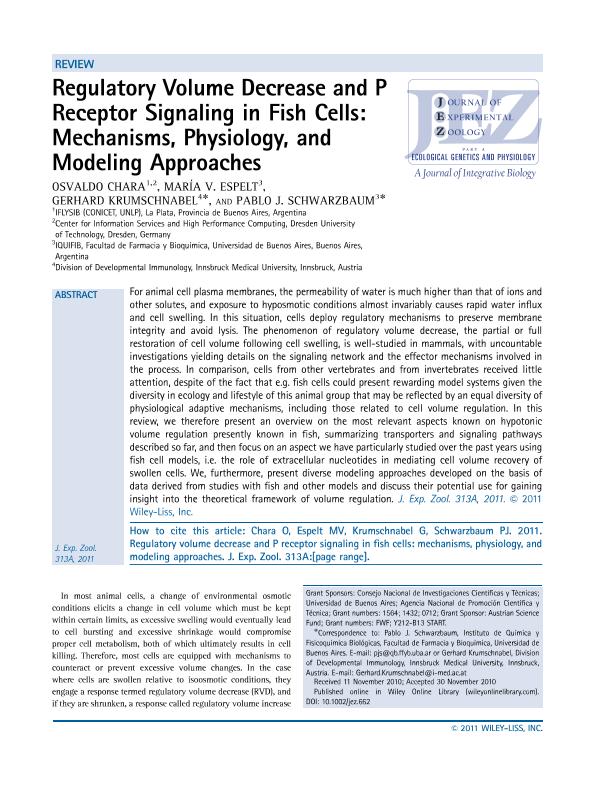Mostrar el registro sencillo del ítem
dc.contributor.author
Chara, Osvaldo

dc.contributor.author
Espelt, Maria Victoria

dc.contributor.author
Krumschnabel, Gerhard

dc.contributor.author
Schwarzbaum, Pablo Julio

dc.date.available
2017-06-14T21:32:05Z
dc.date.issued
2011-04
dc.identifier.citation
Chara, Osvaldo; Espelt, Maria Victoria; Krumschnabel, Gerhard; Schwarzbaum, Pablo Julio; Regulatory volume decrease and P receptor signaling in fish cells: mechanisms, physiology, and modeling approaches; Wiley; Journal of Experimental Zoology Part A: Ecological Genetics and Physiology; 315A; 4; 4-2011; 175-202
dc.identifier.issn
1932-5223
dc.identifier.uri
http://hdl.handle.net/11336/18224
dc.description.abstract
For animal cell plasma membranes, the permeability of water is much higher than that of ions and other solutes, and exposure to hyposmotic conditions almost invariably causes rapid water influx and cell swelling. In this situation, cells deploy regulatory mechanisms to preserve membrane integrity and avoid lysis. The phenomenon of regulatory volume decrease, the partial or full restoration of cell volume following cell swelling, is well-studied in mammals, with uncountable investigations yielding details on the signaling network and the effector mechanisms involved in the process. In comparison, cells from other vertebrates and from invertebrates received little attention, despite of the fact that e.g. fish cells could present rewarding model systems given the diversity in ecology and lifestyle of this animal group that may be reflected by an equal diversity of physiological adaptive mechanisms, including those related to cell volume regulation. In this review, we therefore present an overview on the most relevant aspects known on hypotonic volume regulation presently known in fish, summarizing transporters and signaling pathways described so far, and then focus on an aspect we have particularly studied over the past years using fish cell models, i.e. the role of extracellular nucleotides in mediating cell volume recovery of swollen cells. We, furthermore, present diverse modeling approaches developed on the basis of data derived from studies with fish and other models and discuss their potential use for gaining insight into the theoretical framework of volume regulation.
dc.format
application/pdf
dc.language.iso
eng
dc.publisher
Wiley

dc.rights
info:eu-repo/semantics/openAccess
dc.rights.uri
https://creativecommons.org/licenses/by-nc-sa/2.5/ar/
dc.subject
Rvd
dc.subject
Fish Cells
dc.subject
Mathematical Model
dc.subject.classification
Biología

dc.subject.classification
Ciencias Biológicas

dc.subject.classification
CIENCIAS NATURALES Y EXACTAS

dc.title
Regulatory volume decrease and P receptor signaling in fish cells: mechanisms, physiology, and modeling approaches
dc.type
info:eu-repo/semantics/article
dc.type
info:ar-repo/semantics/artículo
dc.type
info:eu-repo/semantics/publishedVersion
dc.date.updated
2017-06-14T18:55:18Z
dc.identifier.eissn
2471-5646
dc.journal.volume
315A
dc.journal.number
4
dc.journal.pagination
175-202
dc.journal.pais
Estados Unidos

dc.journal.ciudad
Hoboken
dc.description.fil
Fil: Chara, Osvaldo. Consejo Nacional de Investigaciones Científicas y Técnicas. Centro Científico Tecnológico Conicet - La Plata. Instituto de Física de Líquidos y Sistemas Biológicos. Universidad Nacional de La Plata. Facultad de Ciencias Exactas. Instituto de Física de Líquidos y Sistemas Biológicos; Argentina. Dresden University of Technology; Alemania
dc.description.fil
Fil: Espelt, Maria Victoria. Consejo Nacional de Investigaciones Científicas y Técnicas. Oficina de Coordinación Administrativa Houssay. Instituto de Química y Físico-Química Biológicas "Prof. Alejandro C. Paladini". Universidad de Buenos Aires. Facultad de Farmacia y Bioquímica. Instituto de Química y Físico-Química Biológicas; Argentina
dc.description.fil
Fil: Krumschnabel, Gerhard. Universidad de Innsbruck; Austria
dc.description.fil
Fil: Schwarzbaum, Pablo Julio. Consejo Nacional de Investigaciones Científicas y Técnicas. Oficina de Coordinación Administrativa Houssay. Instituto de Química y Físico-Química Biológicas "Prof. Alejandro C. Paladini". Universidad de Buenos Aires. Facultad de Farmacia y Bioquímica. Instituto de Química y Físico-Química Biológicas; Argentina
dc.journal.title
Journal of Experimental Zoology Part A: Ecological Genetics and Physiology

dc.relation.alternativeid
info:eu-repo/semantics/altIdentifier/url/http://onlinelibrary.wiley.com/doi/10.1002/jez.662/abstract
dc.relation.alternativeid
info:eu-repo/semantics/altIdentifier/doi/http://dx.doi.org/10.1002/jez.662
Archivos asociados
